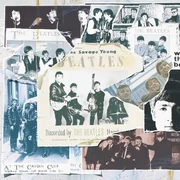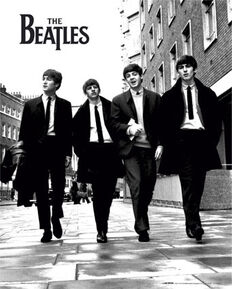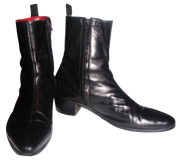 A Good Source For The Beatles Universe And Anything Else Related Welcome To The Beatles Wiki! A wiki founded in 2006 by Vidur about the world's greatest musical act, adopted by Nobody Cares and ListentoMusic in 2010, by Glamra in 2013, KirbyTheBulborb in 2021, and again by BootlegsATrolley in 2024. Ever since 2006, this wiki has given the finest wiki information about The Beatles. And you can help! (Not sure how you can help? Check out this wiki's to-do list.) |
VERY IMPORTANT ANNOUNCEMNET: The Rutles Wiki is moving from the old wiki to a new one due to inactive administration, in other words we are hosting coup against them, so if you are interested please help out by copy and pasting the pages over and reuploaded images.
Beatles News
Featured Song

'I'm Happy Just to Dance with You' is mainly a John Lennon composition (credited to Lennon/McCartney) recorded by The Beatles for the film soundtrack to A Hard Day's Night, and first released on 1 March 1964.
Featured Album
Anthology 1 is a compilation album by The Beatles, released on Apple Records in November 1995. It is the
Featured Article
"I Feel Fine" is a song by The Beatles, written by John Lennon (credited Lennon/McCartney). The song was released as a single and was another hit song for the band. The B-side of the single was "She's A Woman."
The Beatles' eighth single was recorded on October 18 in one of the final sessions for Beatles for Sale. It took eight takes to capture the song's rhythm track. Vocals were added on take nine. John hit upon the distinctive riff for "I Feel Fine" during the sessions for "She's a Woman" about a week earlier. Lennon originally played the opening riff on his Gibson Jumbo Acoustic Guitar equipped with a P-90 pickup though his Vox Amp, hence the woody tone. "I actually wrote 'I Feel Fine' around the riff which is going on in the background," John recalled. "I told them that I'd write a song specially for this riff so they said, 'Yes. You go away and do that,' knowing that we'd almost finished Beatles for Sale. Anyway, going into the studio one morning, I said to Ringo, 'I've written this song but it's lousy,' but we tried it, complete with riff, and it sounded like an A side, so we decided to release it just like that." Before this, "No Reply," "Eight Days a Week" or "I'm a Loser" were being considered for the next single. Lennon's riff would seem to bear a striking resemblance to one found in "Watch Your Step," a 1961 release written and performed by Bobby Parker and covered by The Beatles in concerts during 1961 and 1962.
Did You Know...
- ...that Say Say Say, the duet by Paul McCartney and Michael Jackson, is credited for the introduction of dialogue and storyline into music videos?
- ...that the first song the Beatles recorded was In Spite of All the Danger?
- ...that John Lennon started and ended The Beatles?
- ...that Brian Epstein was gay?
- ...that Paul McCartney and George Harrison were best friends since they met on the school bus in 1954?
- ...that the full interviews of John Lennon, Yoko Ono, and George Harrison are viewable on the Dick Cavett Show page?
- ...that with the addition of the Hey Jude Disambiguation page, the Beatles Wiki became officially 'evil' (666 pages)?
- ...that both Cynthia Lennon and Yoko Ono were older than John?
- ...that John Lennon and Cynthia Lennon had birthdays on consecutive days of the month? (9 October and 10 September, respectively.)
- ...that the above means that their birthdays are 9/10 and 10/9, although which is which depends on which date format you use?
The Beatles

Every record was a shock when it came out. Compared to rabid R&B evangelists like the Rolling Stones, the Beatles arrived sounding like nothing else. They had already absorbed Buddy Holly, the Everly Brothers and Chuck Berry, but they were also writing their own songs. They made writing your own material expected, rather than exceptional. As musicians, the Beatles proved that rock & roll could embrace a limitless variety of harmonies, structures, and sounds; virtually every rock experiment has some precedent on Beatles records. As a unit the Beatles were a synergistic combination: Paul McCartney's melodic bass lines, Ringo Starr's slaphappy no-rolls drumming, George Harrison's rockabilly-style guitar leads, John Lennon's assertive rhythm guitar — and their four fervent voices. As personalities, they defined and incarnated Sixties style: smart, idealistic, playful, irreverent, eclectic. Their music, from the not-so-simple love songs they started with to their later perfectionistic studio extravaganzas, set new standards for both commercial and artistic success in pop.

